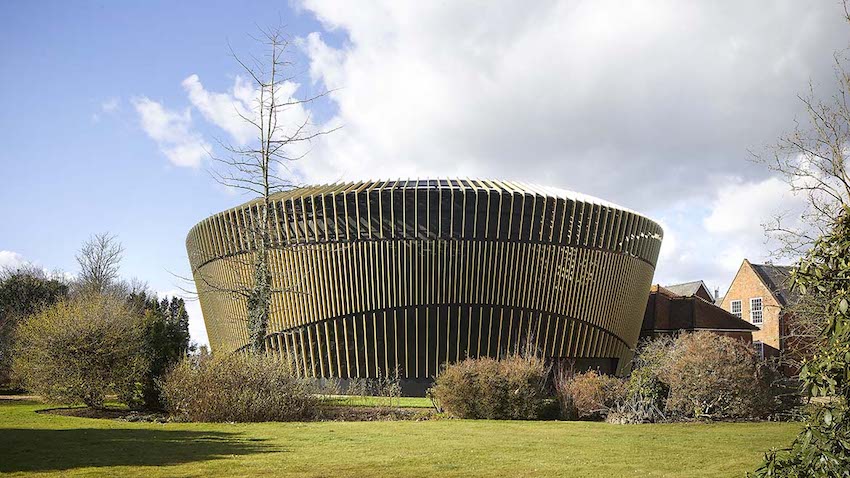Harmonizing Spaces: Acoustics, Architecture, and Cultural Context in Performance Venue Design
 1 AIA LU/HSW; 0.1 ICC CEU; 0.1 IACET CEU*; 1 AIBD P-CE; AAA 1 Structured Learning Hour; This course can be self-reported to the AANB, as per their CE Guidelines; AAPEI 1 Structured Learning Hour; This course can be self-reported to the AIBC, as per their CE Guidelines.; MAA 1 Structured Learning Hour; This course can be self-reported to the NLAA.; This course can be self-reported to the NSAA; NWTAA 1 Structured Learning Hour; OAA 1 Learning Hour; SAA 1 Hour of Core Learning
1 AIA LU/HSW; 0.1 ICC CEU; 0.1 IACET CEU*; 1 AIBD P-CE; AAA 1 Structured Learning Hour; This course can be self-reported to the AANB, as per their CE Guidelines; AAPEI 1 Structured Learning Hour; This course can be self-reported to the AIBC, as per their CE Guidelines.; MAA 1 Structured Learning Hour; This course can be self-reported to the NLAA.; This course can be self-reported to the NSAA; NWTAA 1 Structured Learning Hour; OAA 1 Learning Hour; SAA 1 Hour of Core Learning
Learning Objectives:
- Explore the impact of architectural elements on sound quality and the auditory experience in performance venues by analyzing highlighted case studies. Understand the relationship between architectural detailing and acoustic considerations, emphasizing strategies employed—like spatial arrangement, orchestra placement, material selection, and ceiling design—to create an optimal acoustic environment prioritizing occupants' experience.
- Evaluate the influence of integrating acoustics, architecture, and cultural context on user experience, safety standards, and well-being within the featured performance venue spaces.
- Examine the integration of technical acoustic solutions and aesthetic nuances in architectural designs for performance venues. Assess how these elements enhance sound quality, reduce noise, and ensure user comfort and safety factors, including ventilation, lighting, and emergency egress.
- Investigate how cultural context shapes the design and construction of acoustic spaces, citing projects like the Hungarian House of Music and a performance venue at Brown University. Analyze how architects leverage cultural aspects to create distinctive and resonant acoustic environments.
This course is part of the Acoustics Academy
This course is part of the The Acoustics Academy
Below are a set of links to building type studies from Architectural Record, which are in-depth analyses of particular kinds of buildings, with photos, drawings, specifications, detailed descriptions, and design solutions. Click on each link below, read the article then complete the quiz to earn your credit and certificate of completion.
This course delves into the intricate fusion of acoustics, innovative architectural detailing, and the cultural context shaping exceptional performance spaces worldwide. Drawing inspiration from illustrious projects like New York’s David Geffen Hall, a Stockholm concert hall, the Hungarian House of Music, the music hall at an English boarding school, and a performance venue at Brown University, here we will explore the symbiotic relationship between architectural design elements and their profound impact on sound quality.
Unveiling the nexus between technical acoustic solutions and aesthetic nuances, this course navigates the integration of sound-conscious architectural detailing within a range of performance spaces. Moreover, it examines how architects leverage natural surroundings, cultural context, and cutting-edge technologies to craft unique acoustic environments that resonate with their surroundings.
Through a series of Architectural Record case studies, you will gain insights into the strategic design choices influencing the acoustic performance and cultural significance of these exceptional spaces. By exploring these projects, architects and designers will grasp the artistry and technical know-how required to create immersive, culturally resonant performance venues that harmonize with their environments.
A Stockholm Concert Hall Combines Top Acoustics with Delicate Details
Andrew Ayers
A Friendlier, More Intimate David Geffen Hall Makes its New York Debut
James S. Russell, FAIA Emeritus
At an English Boarding School, a Music Hall That Itself Is a Finely Tuned Instrument"
Sou Fujimoto Melds the Hungarian House of Music with its Natural Surroundings"
Naomi Pollock, AIA
A Performance Venue at Brown University Gives the Arts Top Billing"
Joann Gonchar, AIA

Photo © Hufton + Crow
Completed in late 2022, the 750-seat Centenary Hall is part of a larger music education complex on the campus of Benenden School, an all-girls boarding school in Kent, England.
 |
Armstrong World Industries is a leader in the design and manufacture of innovative commercial ceiling and wall systems. At home, at work, in health-care facilities, classrooms, stores, and restaurants, Armstrong Ceiling & Wall Solutions offer interior options that help
create healthy, sustainable spaces that protect people and cultivate well-being and comfort so they can be at their best.
Armstrong is committed to developing new and sustainable ceiling solutions, with design and performance possibilities that empower its customers to create beautiful, high-performance residential and commercial buildings. Armstrong continues to grow and prosper for the benefit of all its stakeholders. armstrongceilings.com/commercial |






